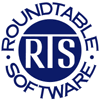

Roundtable Software Newsletter #44, December 18, 2006
|
Want to subscribe to future issues of our newsletter? Click here!
|
|||
In this issue...
| Bank Rec for Windows Beta Testing Ends Soon! | ||||
| The beta testing period for our new Windows-based Bank Reconciliation module ends on December 31st. If you have enrolled for the beta test we ask that you submit your completed test form (included with the beta test in the PDF file) by that time. End-users who submit completed forms by this date will be eligible for the special discount discussed in the email that accompanied your testing instructions. Beta testers thus far have reported only a few isolated problems, all of which have been corrected, so barring unforeseen developments we expect to be shipping the full release version of the product in January. |
||||
| Patch 28 Released | |||||||||||
|
Be sure to review the instructions for loading this patch; it involves more that just the program files being updated!
|
|||||||||||
| There were a number of changes to Payroll for creating 2006 W-2s and for next year's tax calculations. Please be sure to download and install this patch before attempting to print W-2s.
Changes are: |
|||||||||||
|
|||||||||||
|
Click here to download this patch and be sure to read the instructions on how to load this patch.
|
|||||||||||
| W2 Preparation Checklist | ||||||
| Click here to download a PDF of this checklist. | ||||||
Before you attempt to print 2006 W-2s, be sure to follow this checklist of procedures:
|
||||||
| eFile Prep Available for Pre-Orders | ||||
| As discussed in the previous newsletter, there will be no DOS or Unix character-based version of the MMRS package available this year. The new version, now named Federal & State eFile Prep, is a Windows-based application, part of our new Windows-based interface. This application is required for those who submit 250 or more W-2s or 1099-MISC forms to the federal government, and is highly recommended even for those who submit less as a convenient alternative to producing and filing stacks of paper forms. The 2007 edition of Federal & State eFile Prep takes into account all changes instituted by the IRS and SSA for 2006 filing, of which there were quite a few. DO NOT attempt to use a previous year's version of the program as it does not conform to the 2006 submittal format and will be rejected by the IRS/SSA. The 2007 edition of the Federal & State eFile Prep also includes a new option for submitting the non-standard state electronic return now required by the state of California. This edition does assume that you have installed our patch #28 and will not work correctly without that patch installed. The application will be released by the end of this year, with a suggested retail price of $595. Your dealer is accepting pre-orders now. |
||||
| RTS-Advantage for Unix Now Available on CD | ||||
| RTS-Advantage version 4 is now available on CD-ROM as well as 3.5" diskette. The CD-ROM distribution uses the standard Unix Rock Ridge CD format. When ordering Unix product please state your preference. | ||||
| How The New Allowance Screen of the Payroll Tax Tables Work | ||||||
| Click here to download a PDF of this discussion. | ||||||
| The new allowance page has been created in order to comply with the newly revised Alabama state withholding tax instituted for tax year 2007. However, it may well have application outside of that calculation. First of all, it is important to understand that all the calculations this screen performs are based on the employee's gross wages being within a certain range. This determination is ALWAYS based on gross--it does not matter whether the overall table is a Gross, Net or As Is table. The gross wages that are used are based on whether the overall table is annualized or not. If the table is not annualized, the gross used is that on the employee's current check; otherwise the gross is calculated as the pay period gross wages multiplied by the number of pay periods per year. All amounts calculated on this screen are added to those calculated on the first screen of the deduction table, and this combined result is fed into the table calculation, which used to be the second screen but is now the third. The top portion of the allowance screen calculates general allowances based on gross wages, the bottom half calculates allowances based on gross wages and the employee's declared number of dependents. Allowances Based on Gross Wages
Here's an example: The taxing authority states that an employee making between $20,000 and $30,000 per year gets an allowance of $1500 less $25 per $500 of the amount over $20,000. This calculation would require two lines. The first line would provide a flat allowance of $1500:
The second line would deduct $25 per $500 of the amount over $20,000:
Allowances Based on Dependents This portion of the screen may have up to four calculations, and more than one calculation may be made for a given employee. If the employee's gross wages fall with the range specified, then the calculation will be made and added to all previous calculations. For a given line, if the employee's gross wages fall within the ranges, then the specified number of dependents will be multiplied by the Multiply By amount specified. |
||||||
Roundtable Software Home | Add-On Products | Custom Programming | Support Services | Power Utilities | Partners | What's New | Site Map
|
|
||||
 |
||||
| Roundtable Software • 30831 Cove Road • Tavares, FL 32778-5164 (352) 253-9779 • FAX: (815) 572-5446 All contents copyright © 2000-2008 Roundtable Software. All rights reserved. |
||||